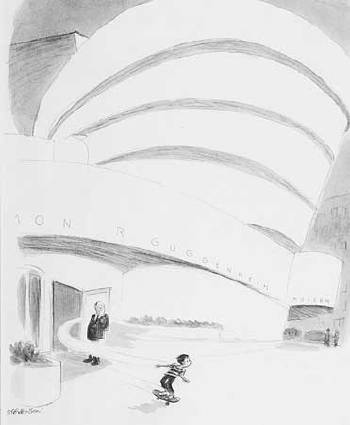E.B White with the benefits of hindsight
21 juni 2011 | In Uncategorized | Comments?Almost shockingly, E.B. White’s essay ”Here is New York” takes a turn to the macabre. Published in 1949, the following passage strikes the reader as remarkably contemporary:
”The subtlest change in New York is something people don’t speak much about but that’s in everyone’s mind. The city, for the first time in its long history, is destructible. A single flight of planes no bigger than a wedge of geese can quickly end this island fantasy, burn the towers, crumble the bridges, turn the underground passages into lethal chambers, cremate the millions. The intimation of mortality is part of New York now: in the sound of jets overhead, in the black headlined of the latest edition”
It continues:
”All dwellers in cities must live with the stubborn fact of annihiliation; in New York the fact is somewhat more concentrated because of the concentration of the city itself, and because, of all targets, New York has a certain clear priority. In the mind of whatever perverted dreamer who might loosethe lightning, New York must hold a steady, irrestible charm.”
The WTC not being conceived of yet, White thought the likely target to be the soon to be raised United Nations building.
A tale of three cities
20 juni 2011 | In Self-indulgence | Comments?(Another rare venture, this time into travel writing).
Five minutes out of a long, cold shower, and only five minutes before the late night Manhattan heat and humidity knocks me over again, so I better make this quick:
In his famous essay ”Here is New York”, E.B. White writes that there are roughly three New Yorks. One consisting of the people who have always lived here, who brings the history, the stability, the foundations for the city. These are basically unimpressed people. Then, the settlers, for whom New York was the big goal. These people bring the joy, the creativity, the drama. But, importantly, we also have the third New York: the commuters. The people who only work here. White is not too kind to these people, but credits them with the nerve, the pulse, the restlessness. ”This New York is the city that is devoured by locust each day and spat out each night”, White writes.
The relative absence of this category, as a big article in the Village Voice pointed out, is one reason for staying in the city during the summer. White seem to think of them as soul-less creatures, based on their obsession with time-tables and reluctance to walk aimlessly in Central Park. Meaning that you don’t actually have to wait until summer, the Park and, by implications, the museums and restaurants (at night time) are free of these people as well. White may recognize that they are needed for economic reasons, but he’s not too happy about it. And while the reslessness accounts for many of the bad things associated with New York (the stress, the rudeness), perhaps there are good things too. Even the creative settlers often end up doing work in organizations, firms, theaters, partly run by commuters, and thus being forced to deliver the goods.
Three New Yorks, as anyone will tell you as soon as look at you, is a massive underestimation. It takes three minutes by foot from Ivy League Columbia to what seems like deepest Harlem. A fancy restaurant may be located less than a block from a location where it would be unimaginable. If Jon Stewart is in the audience and hears the start of a predictable joke on Letterman, he can run over to his own studio, press ”record” and yet beat Letterman to the punchline. The thing with the true, large, number of New Yorks is that many of them are really tiny. In most places, if you feel that you just walked into the wrong neighbourhood, you better turn around. Here, for the most part, you just keep walking until it changes again.
This time, we are visting the children’s New York (the true New Yorkers perspective of which is excellently described in Alan Gopnik’s ”Through the Children’s gate”). This means playgrounds, Museum chases, reluctant shopping and what can only be desribed as a version of the Stendhal Syndrome at FAO Schwartz. It also means, as any New York visit does (and any visit at the Metropolitan Museum of Art, for that matter), that you will rush and briefly note things that in fact merit all your attention. I passed the Seinfeld diner today, and didn’t even stop for a photograph. We’re in the city where the bookstore The Strand is, and are actually considering giving it a miss.
Wishing that we could stay and longing to be back home again. Comitting touristy mistakes and doing touristy stuff, yet so nearly mentally living here already. Opinionated about zoning laws, public transport, rent control. Trying to squeeze yet another item in, catching the right train and so, finally, Worrying, that by coming here nearly every year, we’re turning into E. B. White’s commuters. Whenever you go home, it’s just before the fun begins.
